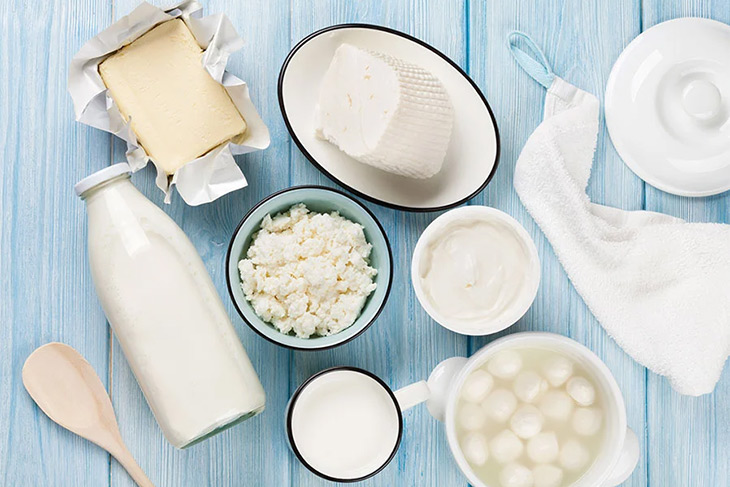Does ditching dairy help you lose weight?

Aussies are drinking less milk than ever, with the average consumption dropping nearly 10 litres per capita in six years. And with the rise in popularity of vegetarian and vegan diets, along with alternatives like soy, oat and almond milk, this doesn’t come as a surprise.
Another reason why many people are ditching dairy is the belief that it can help you lose weight. The thinking often goes that dairy is high in fat and cutting out fat can lead to weight loss. But exactly how accurate is this?
Are you trying to lose weight? Read our comprehensive guide on weight loss to understand where to begin, what happens when you lose weight, and what doesn't work when it comes to dieting.
Cut out dairy, lose the kilos?
Losing weight isn’t as simple as cutting out an entire food group. In fact, including dairy in your diet may actually help you lose more weight than if you remove it completely.
In a meta-analysis of 27 randomised-controlled trials looking at the effects of dairy on weight, CSIRO found that in women aged between 18 to 50, consuming at least two serves of dairy a day, as part of an energy-restricted diet, led to more weight loss and body fat loss compared to a diet low in dairy.
Dairy is rich in nutrients, like calcium, protein and fatty acids, and the researchers believe these nutrients help to increase fat loss, retain muscle mass and regulate appetite.
Studies in the analysis found similar weight loss benefits with both regular and low-fat dairy products.
What are the health benefits of dairy?
Eating a balanced amount of food across the different food groups is important not only for weight management, but for overall health and wellbeing. While dairy products – particularly cheese – can be high in fat, they also contain a range of other nutrients that support good health:
- Dairy is an excellent source of protein; it contains all the essential amino acids your body needs to build, repair, grow and function well. Protein also helps to keep you feeling fuller for longer.
- Dairy is rich in vitamins and minerals like vitamin B12, magnesium, potassium, iodine and phosphorus.
- Dairy is rich in calcium, which is an essential mineral for bone health. Consuming a diet low in calcium can lead to osteoporosis – a condition where bones become weak and break easily.
Are there drawbacks to consuming dairy?
Not everyone can tolerate dairy. Lactose intolerance is widespread around the world, especially in parts of Asia, Africa and eastern Europe.
If you are lactose intolerant and still want to enjoy the benefits of dairy, you could try A2 milk. A2 milk refers to the type of protein (beta-casein) found in A2 milk compared to regular milk which contains both A1 and A2. Some people with a lactose intolerance find they can tolerate A2 milk better than regular milk.
Dairy is also high in saturated fat or unhealthy fat. However, there are different types of saturated fat, and recent studies have found the type found in dairy products may not be as harmful as the type found in butter or highly processed foods. If you consume an otherwise healthy diet, some saturated fat isn’t the end of the world. So go ahead and enjoy a splash of regular milk in your morning coffee if it’s something you enjoy! If you’re trying to lose weight, opt for low-fat or skim varieties of dairy products to reduce your total fat and kilojoule intake.
Learn more: Healthy fats vs bad fats: fatty foods that are good for weight loss
Since dairy is an excellent source of nutrients that support health and weight loss, it’s one of the essential food groups on the CSIRO Total Wellbeing Diet.
The CSIRO Total Wellbeing Diet recommends two to four serves of dairy per day. One serve equates to a cup (250 ml) of low-fat milk, two slices of low-fat cheese or a 175 g tub of yoghurt.
If you choose to ditch dairy completely or cut down on your consumption, it’s important to include alternatives that deliver calcium.
The amount of calcium you need changes over the course of your life. The Australian Dietary Guidelines recommend:
- 1,300 mg per day for teenagers.
- 1,000 mg per day for adults 19 to 50 years.
- 1,300 mg per day for women 51 years and over and men 71 years and over.
Top food sources of calcium per serve:
- Dairy products (milk – 300 mg/250 mL, yogurt – 263 mg/ 175 g, hard cheese – 250 mg/30 g)
- Tinned fish with tiny edible bones (sardines) – 540 mg/100 g
- Calcium-fortified soy products (firm tofu – 320 mg/100 g, tempeh – 334 mg/100 g, fortified soy milk – 300 mg/250 mL)
- Calcium-fortified cereals (200 mg/40 g) and breads (200 mg/two slices)
- Legumes (chickpeas – 186 mg/150 g, lentils – 75 mg/150 g
- Nuts and seeds (almonds – 18 mg/7.3 g, sesame seeds – 5 mg/6.5 g)
- Dark leafy green vegetables (cooked spinach – 100 mg/cup, broccoli – 45 mg/cup). Please note: calcium from dark leafy green vegetables isn’t absorbed as easily as other sources.
Looking for weight loss motivation, dinner inspiration or exercise ideas? Check out the CSIRO Total Wellbeing Diet blog or take a look at some of our delicious, healthy recipes.
